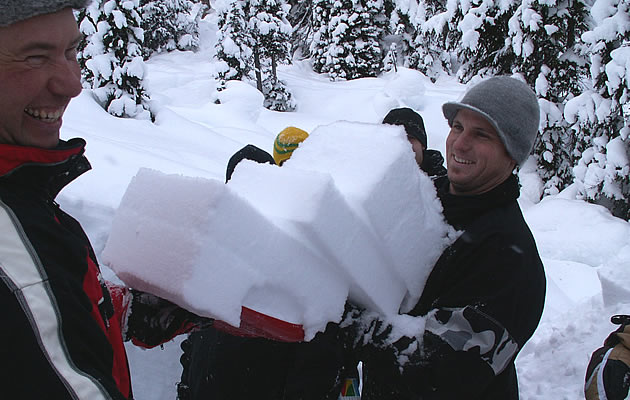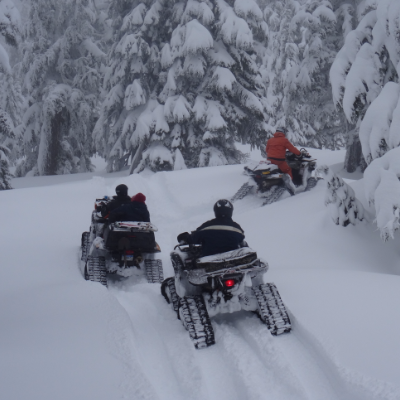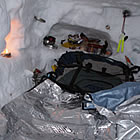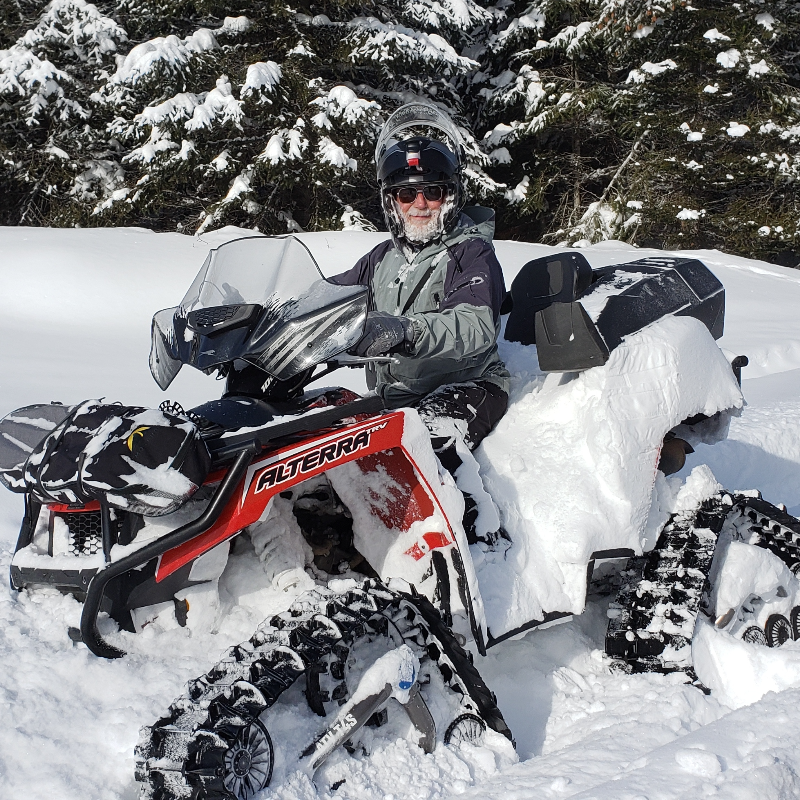Have you ever had a neighbour that even after years still didn’t fit into the rest of the neighbourhood? How about ones that moved in and immediately made friends? Neighbours are just like snowflakes. No two are alike and they are always changing. Some bond well together and make strong relationships. Some never, ever really connect with the rest of the pack. Just like we adjust our actions around our neighbours, we need to adjust our actions around layers in the snowpack.
Follow along with our goofy example as we compare the mountain snowpack to a small-town neighbourhood. Authors' note: In no way are our comments meant to offend. This is simply a fun analogy to help build an introductory understanding of snow.
Bonding well
New families that move into town and within a few days begin bonding well with their neighbours are similar to new snow that lands on the top of the pack. Maybe the snow came from a recent storm; maybe it was moved there by the wind. As long as the snow surface, or the existing neighbourhood, is friendly, this new addition to the pack will likely bond and strengthen within days, sometimes even within hours.
Below are three ways professionals might manage this type of situation.
In the wood:
- Travel elsewhere and wait to give the snowpack a chance to strengthen following the recent storm.
- Even after waiting for initial instabilities to heal, still approach the slopes with caution. Start in lower consequence areas and only work into the terrain if the feedback from the snow confirms its stability.
- Acknowledge that size matters. Larger, more intense storms may take longer to stabilize.
In the hood:
- Be alert to new arrivals but give them a chance to settle in before asking for a tour of the house.
- When first approaching the new neighbour, reach out in a small way to test the waters. Borrow a cup of sugar before you ask to borrow their new ride-on lawnmower.
- Acknowledge that size matters. Larger, more intense egos may take longer to get to know.
Weak in character
Now use your imagination to visualize your least favourite neighbour.
Were they like that when they moved in? Chances are, they had some irritating characteristics but no one really got too concerned about them as the newcomer really was not a big part of the neighbourhood yet. Besides, there was still the chance that they might shift a bit and fit in.
As time goes on and the irritating neighbour gets more involved in the community, it is then that they are more likely to disturb the peace.
This situation is like the resistant crystal formation of surface hoar (hoarfrost) that occasionally forms on the top of the snowpack. Surface hoar is called a PERSISTENT weak layer as its character is really resistant to change, allowing this weak layer to PERSIST for a long period of time. Just like long-term, irritating neighbours, these layers can become a bigger problem over time. Over time, more load and stress is applied. Now the layer, or neighbour, is buried more deeply in the overall structure. If a tipping point is reached, the incident has the potential to be much more dramatic, as it will likely affect a much larger area and lead to larger consequences.
Below are three ways professionals might manage this type of situation.
In the wood:
- Get a big group of riders together and track out and mix up every bad surface crystal that you see. Okay, so this won’t work for snowmobilers but it can improve stability in specific areas. Ski hills benefit from this, for example.
- Call in an avalanche technician, get everyone clear and trigger the slope while the layer is not too deep in the snowpack. Avalanches will be smaller and less destructive. Highway departments might take this approach.
- Avoid the slope, travel elsewhere and wait until the persistent weakness strengthens or gets deep enough in the snowpack that the strength of the rest of the pack overcomes the weakness.
In the hood:
- Recognize the potentially irritating neighbour as soon as they move in. Host a big party and try to help them fit in right away. (This rarely works, but this is as good a reason as any for a party!)
- Call in the bylaw officer to settle the dispute. Don’t wait until the problem gets really out of hand. Act early; there is time to salvage the relationship.
- Avoid the neighbour until they settle down. Move your block parties to the other end of the street and continue to have fun and build relationships with the rest of your neighbours.
Changing in nature
How about another neighbour that started out friendly but later the circumstances change and now there seems to be no hope for reconciliation?
Depth hoar and large faceted layers resemble this type of situation. These snow crystals were no threat initially, but in some seasons the weather patterns may cause the snow structure to morph into a new form that loses strength as it grows. Just like your really irritating neighbour, sometimes these snowpack changes are so intense that a return to stable times is just not possible. These crystals are also referred to as Persistent Weaknesses, often located deep in the snowpack with highly destructive potential.
Below are three ways that professionals may manage this type of situation.
In the wood:
- Avoid slopes with this snowpack, especially after recent stressors like wind, snow and significant warming.
- Stay clear in case the slope triggers naturally or from human stress. There's no point in taking a risk with a deep instability if we don't have to.
- Call in an avalanche technician, get everyone clear and trigger the slope. Hopefully it avalanches right to the ground and the new snowfalls bond better. Highway departments might take this approach.
- Find other slopes. Avoid this weak structure and wait until the snowpack melts out in the spring.
In the hood:
- Tread lightly around this neighbour to avoid a confrontation, especially when their mother-in-law is in town.
- Avoid the area around the neighbour's yard completely. Even when everything looks good from the outside, you may not be really sure about what is going on in the basement.
- Call in the local authorities. Stay clear and watch the officers remove the evidence of your neighbour's illicit operation. Hope the new family that moves in has different business interests.
- Be content to make your fun somewhere else. Wait until your neighbour moves out of town.
Realize that there's a lot going on underneath
With any luck, this silly discussion has helped clarify that there can be a variety of relationships going on in the snow. We must take this into consideration every day that we ride. Timing is everything. The greater our appreciation for snow, the better our ability to choose activities that suit the local avalanche conditions.
Public avalanche bulletins issued by the Canadian Avalanche Centre are the first step in identifying the character of the snow and should be reviewed before EVERY backcountry trip. Why not learn about the neighbourhood before you tour the local showhomes!
Learn to use your sled to your advantage. Snowmobilers have more options than they realize. A Zac’s AST Level 1 class will surprise you with a common-sense approach to mountain sledding and open a whole new series of choices that you likely have never considered. What have you got to lose? Sign up today!
Quote code SnR25 for a $25 discount from your AST1 class. See the Zac’s Tracs website for program details.







